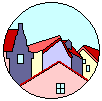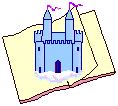
Find more
FREE educational software at the
Owl and Mouse Home
Page.
Click Here
|
|
Make a
Village
A learning project to
create a model village using free software
Kids
will learn that towns are made up of houses and stores;
how towns grow; that someone has to plan where the
streets and houses will be; that stores are usually
clustered together (and this is sometimes enforced by
zoning), and put where people can get to them easily.
They will also discuss the economics of stores--each
store has to have a customer base of a certain size to
keep going, and that stores provide employment for some
of the people in the town. Use your PC printer and
"Make a Village" free software to print out
patterns for 10 houses and 7 stores for kids to color,
cut out, and fold up into 3-dimensional buildings and
arrange into their own village. Additionally, students
will learn how a two dimensional piece of paper becomes a
three-dimensional object.
Material needed:
scissors
cellophane tape or glue
crayons, markers or colored pencils
patterns for houses, church and apartment house:
Go To Make a Village Online
Strongly
Recommended:
large piece of butcher paper or
several pieces of green construction paper fastened
together for fields.
You can print
on ordinary computer paper, or on thicker paper if
desired. (you will probably want to use paper heavier
than most computer paper if a number of children are
doing the project.) Check your printers instructions
before printing on heavy paper--some do and some
don’t. You can also take your printouts to a copy
shop and copy onto heavier paper or enlarge.
It is best to color the
buildings before cutting them out. When coloring, you
should turn the building around so that you are coloring
each side "right way up". You can decorate and
add things to the buildings, (curtains, a doorknob, a cat
in the window, houseplants, and flowers and bushes,
stained glass in the church).
Cut out the patterns on the
heaviest black outline, cutting around the tabs where
they occur. You can cut the doors on one side and across
the top, so that they open. Notice the door for the
chickens on the chicken house--on it, cut the two sides
(vertically), as it swings from the top.
Fold the house on all the lines,
including the tab lines. When you hold the buildings with
the colored side toward you, all folds are away from you
(blank sides of the paper together), and at 90 degree
angles when you are finished. Fold everything, then glue
or tape the tabs on the inner (flat) roof to the sides of
the house. Then fasten the back of the house to the
sides. The sides will stick up to hold the roof. The tabs
on the side piece can be used to hold the roof in place
(or cut off, if you prefer). If you want the doors to
open, be sure to cut the doors before you assemble the
building
Students can arrange their
houses and stores on the paper, and discuss what
arrangements are best--where to put streets, where to put
stores. The blank store can be made into a police or fire
station. Students can decide if the town just
"grows" by students placing houses in order, or
if they want a planned system of streets. Have they
arranged the houses so that every house has a driveway?
Does the town have alleys in back of the houses? Where
are the parks? How much land, and where, is devoted to
public use, such as a police station, city hall, etc.
Fire codes generally dictate
that each dwelling have a front and back door. Discuss
codes and zoning, and the reasons for various ordinances
in terms of public safety, and possibly property values.
(A side lesson on federal laws, state laws and city
ordinances could be brought in here.)
(A math lesson in topography and
area can be inserted here--how many houses for a certain
area if yards have to be a certain size? How many more
houses if the yards are smaller? Do you get more houses
per area if all streets are arranged in a grid, or if
some of the streets are dead ends? (cul de sacs)? What
are the other advantages or disadvantages of various
street arrangements?)
Explain about how towns grow.
Older towns generally started with a few houses, and then
a store or two to serve the needs of the inhabitants.
More houses, and more specialized stores were then built.
(This is an excellent lead-in to a field trip to older
parts of town, or to an older town in your area.) In
cities built before 1900, there were arrangements for
stables, either for each house or for people to rent
horse, or horse-drawn carriages to hire for a ride. How
did the availability of public transportation affect the
town’s growth? Could people live further away from
where they worked with cars?
What utilities are in the town?
Where are the wires for electricity and telephones? Pipes
for water? Sewer pipes? How is garbage collection
arranged? Do people get natural gas into their houses? Do
they have underground oil tanks in their yards?
Styles of houses have a variety
of sources, generally from Western Europe. Flat-roofed
adobe houses originated in Southern Europe, around the
Mediterranean, when it was warm and rain was not very
common. The "Swedish" house is built of wood,
and the design in roughly based on country houses in
Sweden. The church is typical of small New England
churches, with a bell in the steeple to call people to
services, or announce important news (such churches were
common where the town was small enough for everyone to
hear the bell.) However, the round window in front is a
small echo of the windows in cathedrals, as are the long
side windows. The thatched cottage has design features
that go back to the cottages of Shakespeare’s time.
Discuss with the students about
their town. Have them think about:
Where do people work?
Are there farms nearby?
Is there a manufacturing plant in this town?
Do parents commute to downtown?
|
|


